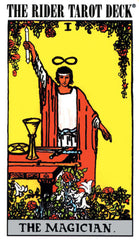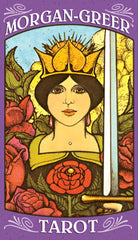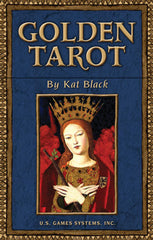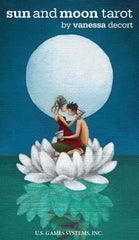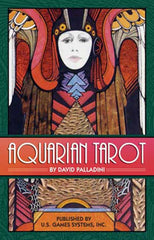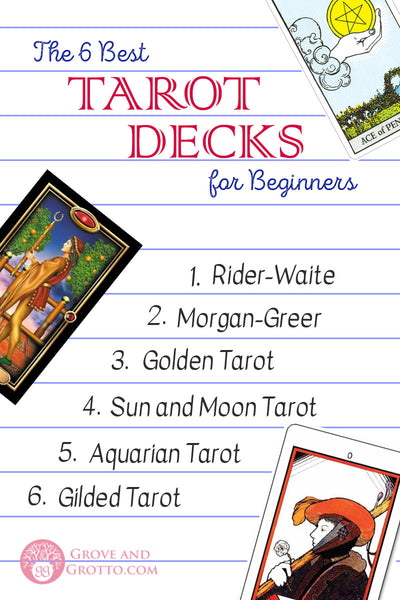
Picking out a first Tarot deck shouldn’t be a monumental task. And yet, with so many different decks on the market today, lots of beginners are intimidated by the sheer number of options. It’s true that you can never have too many decks. But it’s also true that you have to start somewhere.
I’ve cut through the massive number of Tarot decks to recommend six classic versions that won’t lead you astray. Whether you’re choosing a first deck for yourself or as a gift, one of these decks is sure to be a good fit.
I used three criteria when choosing these top beginner’s decks: First and foremost, I looked for decks that are easy to use for newbies. Tarot is already esoteric—there’s no reason to make it even more cryptic when you’re first learning. Decks that meet this requirement are fully illustrated, with clearly titled cards and a traditional 78-card structure. (More often than not, they’re also based on Rider-Waite, the world’s most enduring deck.) Historic and experimental decks didn’t make the beginner’s list.
Secondly, I looked for decks that have a good range of energy and emotion. Tarot tackles human experiences from the highest highs to the lowest lows. There are fiery cards and watery cards and grand cards and petty cards. Beginners’ decks should reflect this diversity. I’ve avoided including those artistic decks that—while they may useful to more experienced readers—have a same-y quality to their artwork.
Finally, I only chose decks for this list that are currently in print and/or readily available. This is not just so I can sell you a Tarot deck. (Although I’d be happy to!) It’s because choosing a first deck is hard enough without trying to chase down rare or collectible editions.
So here they are—my six picks for a beginner’s Tarot deck. If you found me at my booth and asked me to help you pick a first Tarot deck, chances are you’d walk away with one of these:
It may be a boring list-leader, but I always recommend the classic Rider-Waite Tarot to beginners. Why? Because over a century after its debut, it still gives readings that are precise, clear and deep. These stark line drawings have a psychic resonance that is simply unmatched by many newer decks.
Another plus? Rider-Waite has formed the basis for the vast majority of illustrated Tarot decks. If you learn Rider-Waite well, switching to another deck later will be a breeze.
My favorite is the Centennial Edition, which is a re-colored version of the classic 1910 deck. It has gentle colors and a fabulous vintage feel.
Ciro Marchetti’s Gilded Tarot has medieval-inspired characters rendered in a colorful digital style. The whole deck is luminous and lucid. I often recommend it to beginners who prefer a more modern-looking Tarot.
One useful innovation of the Gilded Tarot is its color-coded suit cards. (Blue for Water/Cups, red for Fire/Wands, and so on.) This is a great way for beginners to latch on to the elemental correspondences of the Minor Arcana. It’s also useful in readings, to see at a glance which suit(s) are dominant in a spread.
Created in the 1970s, the Morgan-Greer Tarot has colorful, almost cartoony illustrations. But don’t let them fool you—this is a serious deck that works well in the hands of beginners and experts alike. It follows Rider-Waite closely, with only a few departures in the symbolism of the cards.
The close-up, richly colored illustrations lend themselves well to an intuitive reading style. The artwork goes all the way to the edge. The borderless cards seem to interact when read together in a spread.
The absence of full nudity and disturbing imagery makes the Morgan-Greer a good second choice when a Rider-Waite deck may not be appropriate. For this reason, it’s popular with both beginners and professional readers.
The Rider-Waite cast of characters dressed in cloth of gold. Kat’s Black’s Golden Tarot is a digital collage of medieval and Renaissance artwork, recreating all the classic scenes and poses of Tarot. The cards are populated by shining kings and queens, peasants and saints—all sumptuously painted and accented with golden foil. Its deviations are few and judicious. The disembodied hands in the Aces, for example, are replaced in each suit by angels holding the Ace.
The Golden Tarot so heart-meltingly beautiful that it will make beginners want to put in extra hours of practice. While its Christian imagery may be off-putting to some, it is a solid choice for most beginners.
Both gentle and profound, the Sun and Moon Tarot recreates the cards with evocative pastel drawings. Keywords for the Minor Arcana help clue in beginners without being obtrusive. Astrological, elemental and Hebrew letter correspondences appear on the cards, should you wish to dig a little deeper.
The whole deck has a beachy, playful feel, decorated with rocky landscapes and serene ocean views. The vibe is loving and inclusive. This is a deck for the yoga crowd that doesn’t strip Tarot of its depth or gravity.
The Aquarian Tarot is so stylish and timeless—medieval manuscripts and Art Deco and 1960s poster design all put in a blender and whirred into a delicious pulp. If that sounds yummy to you, then this may be your deck.
The Aquarian deck is not for everyone. Some find its watercolor palette too bland, its stylized, ethereal human figures too distant. Some find that it reminds them irredeemably of the patchouli stank of their 70's dorm room.
Still, the Aquarian’s loyal fans have kept it continuously in print for almost 50 years. Many people have told me that it was their first deck, and still their favorite. The Aquarian Tarot is an exceptional reading deck that is aligned with—but never dependent on—the Rider-Waite system of Tarot.
We love Tarot (and have lots to say about it)! Shop for decks, read more Tarot articles, or browse the entire archive.

